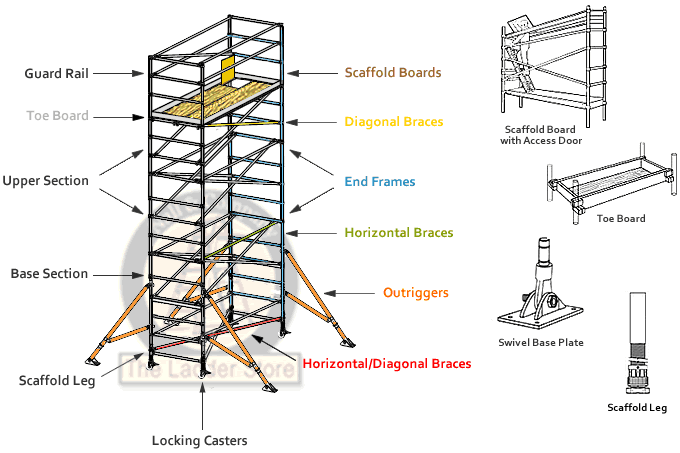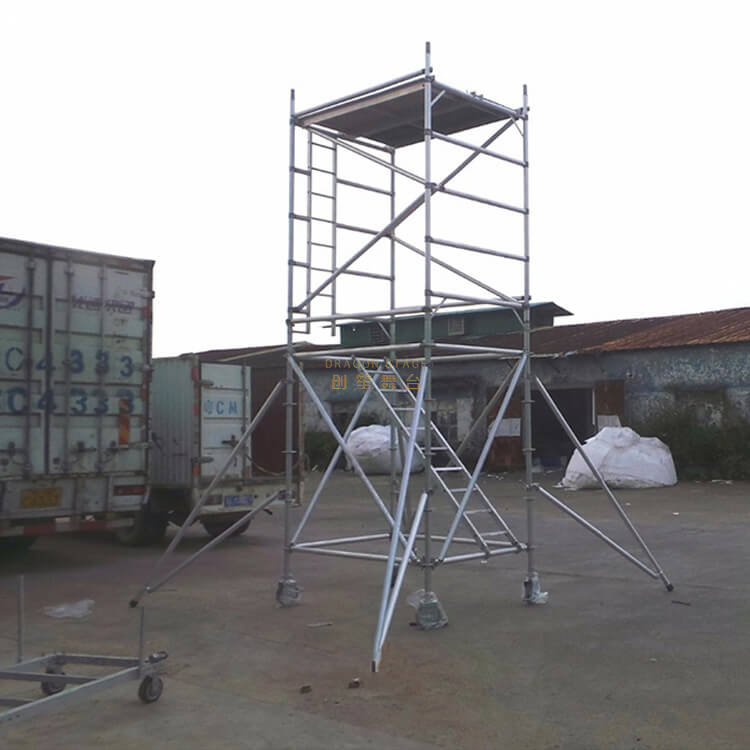Exactly How Scaffolding Adds To a Safer Building Site

Selecting Scaffolding Products: Steel Vs. Aluminium
Steel scaffolding provides sturdiness and strength, perfect for projects needing changes and boosted efficiency. While aluminium scaffolding is light-weight, corrosion-resistant, and easier to transfer and set up. Consider steel's higher tons ability and long life, versus aluminium's reduced maintenance needs. Steel has a lower ahead of time cost, yet aluminium may be a lot more affordable long-term. While aluminium is lighter and extra mobile, steel excels in strength. The option effects project success, so review the particular demands thoroughly. Find out more about the benefits and factors to consider of each material to make an informed decision.
Benefits and drawbacks of Steel Scaffolding
Steel scaffolding is a generally used building and construction product recognized for its sturdiness and toughness. Among the vital benefits of steel scaffolding is its ease of setting up. Because of its strong nature, steel scaffolding can be swiftly put up and dismantled, making it a popular choice for jobs that require frequent modifications and activities. This ease of assembly adds to boosted effectiveness and productivity on building sites.
In regards to maintenance demands, steel scaffolding is reasonably low-maintenance contrasted to other products. Its robust nature permits it to withstand harsh weather conditions and heavy tons without substantial wear and tear. Regular assessments and small fixings are normally enough to maintain steel scaffolding in the very best problem, reducing downtime and costs related to comprehensive maintenance.
Benefits and drawbacks of Aluminium Scaffolding
Significant for its lightweight buildings and corrosion resistance, aluminium scaffolding uses unique benefits in certain building circumstances. The light-weight nature of aluminium scaffolding makes it much easier to carry, set up, and take down contrasted to steel scaffolding. This characteristic is particularly valuable in projects where mobility and performance are vital, such as temporary building and construction tasks or tasks that call for regular repositioning of the scaffolding structure.
In addition, aluminium's rust resistance guarantees that the scaffolding stays sturdy and reliable also in outdoor or moist settings where steel scaffolding might be vulnerable to rust.
Nevertheless, in spite of its benefits, aluminium scaffolding may have restrictions in certain scenarios. While lightweight building is beneficial for mobility, it can additionally be a downside in regards to load-bearing capability. temporary roofs Aluminium scaffolding might not be as ideal for durable construction tasks that need considerable weight-bearing capabilities. It is essential to consider the certain demands of the job and assess whether the lightweight and corrosion-resistant buildings of aluminium scaffolding line up with the project's needs.
Sturdiness Contrast In Between Steel and Aluminium
In evaluating the long life of scaffolding products, a significant element to contemplate is the relative resilience between steel and aluminium. When considering this aspect, several essential aspects enter play:

- Corrosion Resistance: Aluminium scaffolding often tends to have much better deterioration resistance compared to steel scaffolding, particularly in outside or moist environments.
- Upkeep: Steel scaffolding typically requires more maintenance to prevent rust and deterioration, while aluminium scaffolding is generally low maintenance.
- Load Capability: Steel scaffolding is understood for its greater lots ability contrasted to aluminium scaffolding, making it preferable for durable construction projects.
- Longevity: While both steel and aluminium scaffolding can be long lasting, steel scaffolding is usually taken into consideration to have a much longer life expectancy due to its robustness.
Thinking about these points is necessary in figuring out the most ideal scaffolding product based upon the certain task requirements and environmental problems.
Expense Considerations: Steel Vs. Aluminium
When comparing steel and aluminium as scaffolding products, a vital aspect to take into consideration is the expense implications related to each option. Steel scaffolding tends to have a lower in advance expense contrasted to aluminium scaffolding. Nonetheless, aluminium scaffolding, while at first extra expensive, can show to be extra affordable in the long run as a result of its lower upkeep demands.
In terms of expense comparison, steel scaffolding is generally less expensive to purchase at first. On the various other hand, aluminium scaffolding might have a greater ahead of time cost, but its resilience and resistance to corrosion can cause reduced maintenance expenses over time. Aluminium scaffolding requires less upkeep because of its all-natural resistance to corrosion and rust. This indicates that while the first financial investment might be higher, the overall price of possession could be reduced with aluminium scaffolding.
Thinking about both the preliminary acquisition cost and long-term upkeep demands, it is vital to consider the cost implications of steel versus aluminium scaffolding to make an informed decision that lines up with both monetary restrictions and lasting economic factors to consider.
Weight and Mobility Aspects

Steel and aluminium scaffolding vary significantly in their weight and portability attributes, impacting their functionality for different building and construction tasks. When taking into consideration the weight and transportability aspects of scaffolding materials, the complying with factors need to be taken into consideration:
- Transportation efficiency: Aluminium scaffolding is especially lighter than steel scaffolding, making it less complicated to move to and from job sites, specifically for tasks that require constant moving of the scaffold.
- Product stamina: Steel scaffolding is recognized for its phenomenal strength, making it suitable for durable projects where high load-bearing capability is necessary.
- Alleviate of setting up: Aluminium scaffolding is simpler to set up and disassemble as a result of its light-weight nature, allowing for quicker arrangement and dismantling times compared to steel scaffolding.

- Rust resistance: Aluminium scaffolding is normally resistant to deterioration, ensuring longevity and durability also in outdoor or damp environments, unlike steel scaffolding which might call for extra protective coatings for deterioration prevention.
Regularly Asked Concerns
Exist Any Details Safety And Security Precautions or Laws That Required to Be Followed When Making Use Of Steel or Aluminium Scaffolding?
Security policies dictate proper use of steel or aluminium scaffolding. Compliance warranties employee safety and security and avoids accidents. Material longevity of steel provides strength yet is larger, while aluminium is lighter however needs mindful handling due to its reduced weight ability.
How Does the Maintenance and Maintenance Differ Between Steel and Aluminium Scaffolding?
When contrasting maintenance and maintenance of steel versus aluminium scaffolding, toughness is a crucial factor. Steel frameworks might call for even more regular evaluations and corrosion prevention measures, influencing long-lasting expenses. Aluminium, while lighter, might demand customized like avoid structural weakening.
Can Steel or Aluminium Scaffolding Be Customized or Changed for Details Job Demands?
Customization choices for steel and aluminium scaffolding can give job versatility, permitting tailored solutions to meet specific needs. Adjustments such as flexible heights, system dimensions, and attachments enhance versatility for diverse building and construction needs.
Exist Any Ecological Considerations to Take Into Account When Finding In Between Steel and Aluminium Scaffolding?
When choosing between steel and aluminium scaffolding, it is essential to think about ecological effect. Aluminium offers recycling benefits as a result of its high recyclability, making it a more sustainable selection contrasted to steel, contributing to green building and construction methods.
Just how Does the Accessibility of Steel and Aluminium Scaffolding Products Vary in Various Areas or Markets?
The schedule of steel and aluminium scaffolding materials differs throughout regions because of market demand, rates, material availability, and transportation expenses. Factors such as regional manufacturing ability and import policies influence the supply chain dynamics.
Final thought
To summarize, when choosing scaffolding products, it is crucial to consider the advantages and downsides of both steel and aluminium.
Steel scaffolding is durable and tough, however larger and much more expensive.
Aluminium scaffolding is lightweight and easily movable, yet may not be as resilient as steel.
Eventually, the choice in between steel and aluminium will depend upon the certain demands of the job and monetary restrictions.
